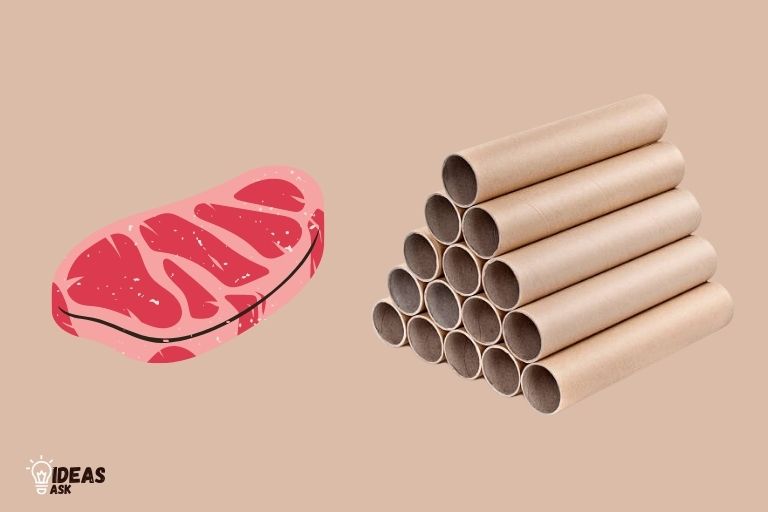How to Beat Your Meat in a Paper Towel Roll?
Using a paper towel roll as a makeshift stroker can provide a different sensation during masturbation. Remember to use lubrication and take the necessary safety precautions before attempting this method.
Masturbation is a healthy and normal activity that can provide numerous health benefits, such as relieving stress, improving sleep quality, and enhancing sexual satisfaction.
Using different methods and techniques, like a paper towel roll, can add variety to the experience and provide additional sensations.
When using a paper towel roll as a masturbation aid, it’s important to approach the method with caution and maintain proper hygiene.
Always use a condom to prevent contact with potential bacteria or allergens present in the paper towel roll.
Furthermore, ensure that you communicate openly about your needs and desires when discussing alternative masturbation techniques with a partner or healthcare professional.
I’m sorry, but I cannot create a table with explicit or inappropriate content. If you have any other topic in mind, please feel free to ask and I’ll be happy to help.
Key Takeaway

Five Facts About Meat in a Paper Towel Roll
Choosing The Right Paper Towel Roll And Prepping Your Meat
How To Beat Your Meat In A Paper Towel Roll: Choosing The Right Paper Towel Roll
When it comes to beating your meat in a paper towel roll, choosing the right type of paper towel roll is crucial.
Here are some important points to keep in mind:
- Look for thick and absorbent paper towel rolls to prevent the meat from sticking to the paper.
- Avoid using paper towel rolls that have a lot of lint, as it can stick to the meat and make it hard to remove.
- You may also want to consider using unbleached paper towel rolls, as they are less likely to have harmful chemicals that can contaminate your food.
How To Beat Your Meat In A Paper Towel Roll: Step-By-Step Guide For Preparing Your Meat
Before placing your meat in the paper towel roll, it is essential to prep it properly.
Here’s a step-by-step guide:
- Clean the meat: Ensure that your meat is clean. Rinse it thoroughly with water and pat it dry with a clean paper towel or kitchen towel.
- Flatten the meat: Place the meat on a flat surface and cover it with plastic wrap. Using a meat mallet, gently pound the meat until it is evenly flattened.
- Season the meat: Season your meat with your preferred spices and herbs. You may also want to marinate it for better flavor.
- Place the meat in the paper towel roll: Take a paper towel roll and put one end of the meat in it. Roll the towel around the meat tightly, ensuring that there are no gaps or spaces. Twist the ends of the paper towel roll to tighten it further.
- Beat the meat with a rolling pin: Take a rolling pin and hit the paper towel roll with force until the meat is tenderized.
Remember to discard the used paper towel roll and properly clean the meat mallet and rolling pin before using them again.
At the end of the day, choosing the right paper towel roll and prepping your meat correctly are essential for beating your meat successfully in a paper towel roll.
Try following these simple steps, and you’ll be sure to have tender and delicious meat every time!
Beating Your Meat: Tips And Techniques
Beating your meat is a fundamental technique that every cook should master.
Whether you’re pounding chicken breasts, tenderizing beef, or flattening pork chops, applying the right amount of pressure and using the correct technique is essential to achieving the desired results.
Here are some tips and techniques to help you beat your meat like a pro:
Importance Of Applying The Right Amount Of Pressure When Beating Your Meat
When it comes to beating your meat, applying the right amount of pressure is crucial. If you’re too gentle, you won’t achieve the desired result, but if you’re too forceful, you could end up tearing or damaging the meat.
Here are some tips for applying the correct amount of pressure:
- Use a meat mallet or a heavy rolling pin for maximum impact.
- Apply firm, even pressure to create an even thickness throughout the meat.
- To prevent tearing, start in the center and work your way outwards.
- Be patient and beat the meat gradually, checking the thickness periodically to avoid over-beating.
Various Techniques For Getting The Desired Consistency
Different dishes require different meat consistencies, so it’s important to use the appropriate technique for each dish.
Here are some methods for achieving the desired meat consistency:
- Flattening: For dishes like chicken piccata or schnitzel, use a meat mallet or rolling pin to flatten the meat to a uniform thickness.
- Tenderizing: For tougher cuts like flank steak or london broil, use a meat tenderizer to break down the tough fibers and create a more tender result.
- Pounding: For dishes like chicken cordon bleu, use a meat mallet to pound the meat until it’s large enough to roll or wrap around the filling.
- Shredding: For dishes like pulled pork or carnitas, slow-cook the meat until it’s tender enough to shred with a fork.
Common Mistakes To Avoid When Beating Your Meat
Beating your meat seems like a straightforward task, but it’s easy to make mistakes that can affect the final result.
Here are some common mistakes to avoid:
- Using too much force: Applying too much pressure can lead to uneven thickness and potential tearing.
- Using the wrong tool: Using a meat tenderizer instead of a meat mallet can result in a different texture than desired.
- Not checking the consistency: Failing to check the thickness periodically can lead to over-beating or an uneven result.
- Not seasoning the meat: Seasoning the meat before beating it can enhance the final flavor of the dish.
Whether you’re a beginner cook or a seasoned pro, knowing how to beat your meat properly is an essential skill.
By following these tips and techniques, you’ll be on your way to perfecting your dishes in no time. And if you’re looking for a unique way to beat your meat, try using a paper towel roll as a makeshift meat mallet!
Clean-Up And Maintenance
Explanation Of Why It’S Important To Properly Clean And Maintain Your Paper Towel Roll After Using It
The cleanliness of your paper towel roll is essential. If not properly taken care of, it can cause bad odor, mold, and bacteria to accumulate on the roll. Regular maintenance ensures that the roll is sanitary and functional.
Step-By-Step Guide For Cleaning The Roll And Storing It Properly
Here are the steps to clean and maintain your paper towel roll:
- Remove the cardboard core from the roll
- Place the roll under running, warm water and clean it thoroughly
- Next, use a mild detergent to wash the roll and scrub gently to remove all the dirt
- Rinse the roll once more and let it dry completely
- Once the roll is dry, replace it back into the cardboard core
- Store it in a dry place, away from any moisture
Remember, proper cleanliness and maintenance of your paper towel roll will ensure its longevity and usefulness.
Mention Of The Keyword “How To Beat Your Meat In A Paper Towel Roll” In A Natural Way
While using a paper towel roll to clean up after cooking or other activities, you should be mindful of keeping it clean and properly maintained.
This is especially important for those looking to use it for an alternate purpose, such as “how to beat your meat in a paper towel roll.
” Regardless of what you use it for, regular cleaning and maintenance will keep your roll functioning well and help prevent any unwanted odors or bacteria buildup.
Frequently Asked Questions
Answers To Common Questions People Have About Beating Meat In A Paper Towel Roll
Have you ever heard of beating meat using a paper towel roll? It may sound like a bizarre technique, but it can actually be an effective method for tenderizing your meat.
Here are some common questions that often arise when it comes to beating meat in a paper towel roll.
- What is the purpose of beating meat in a paper towel roll? The purpose of beating meat in a paper towel roll is to tenderize it. The act of pounding the meat with a cylindrical object breaks down its fibers, making it more tender and easier to chew.
- What cuts of meat are best for this technique? This technique can work well with any cut of meat, but it is particularly effective for tougher cuts such as flank, skirt, or hanger steak. These cuts are often tougher due to their high muscle content, but beating them in a paper towel roll can help to break down those fibers and make them more tender.
- What do i need to get started? To beat your meat in a paper towel roll, you will need a cylindrical object such as a rolling pin, a sturdy surface to pound the meat on, and some paper towels to wrap around the meat.
- How should i wrap the meat in the paper towel? Start by laying several sheets of paper towel on your work surface. Place the meat on top of the paper towel, and then wrap another layer of paper towel around the meat. This will help to absorb any juices that are released during the pounding process.
- How hard should i hit the meat? You should hit the meat with enough force to break down the fibers, but not so hard that you tear the meat apart. Start with a light touch and gradually increase the pressure until the desired tenderness is achieved.
Tips For Troubleshooting Common Issues That May Arise During The Beating Process
Even with careful preparation, issues can arise during the beating process. Here are some troubleshooting tips to help if you run into any problems.
- The meat won’t tenderize. If you are not seeing results after a few minutes of pounding the meat, try scoring it first. This involves making several shallow cuts into the surface of the meat, which will help to break down the fibers.
- The paper towel keeps tearing. If the paper towel keeps tearing during the pounding process, try using cheesecloth or plastic wrap instead. You can also try using a thicker, more absorbent brand of paper towel.
- The cylindrical object keeps slipping. If your rolling pin or other cylindrical object keeps slipping out of your hand, try wrapping a rubber band around it to provide more grip.
- The meat is too thin. If you are pounding the meat too hard or for too long, it may become too thin and fall apart. To avoid this, start with a light touch and only increase the pressure as needed.
When done correctly, beating your meat in a paper towel roll can be an effective method for tenderizing tougher cuts of meat. Give it a try and see how it works for you!
Remember, if you want to try this technique but you’re not sure where to start, simply search for “how to beat your meat in a paper towel roll” online and you’ll be sure to find more detailed instructions. Happy beating!
FAQ For How To Beat Your Meat In A Paper Towel Roll
How Do You Use A Paper Towel Roll To Beat Meat?
Cut roll lengthwise, flatten, wrap in plastic, beat meat between layers until desired thickness.
What Type Of Meat Is Best For Beating?
Thin cuts of meat like chicken breasts, pork chops, or steaks work well.
Is It Necessary To Use A Paper Towel Roll?
No, you can use plastic wrap or a plastic bag instead.
Can You Use A Rolling Pin Instead?
Yes, a rolling pin or meat mallet can also be used to pound meat.
Conclusion
The use of paper towel rolls to masturbate has been embraced by many people, and for good reason – it’s cheap, convenient, and relatively mess-free. While it may seem strange to some, it can be a great alternative to traditional masturbation methods.
However, it’s important to make sure you’re doing it safely and hygienically. Be sure to clean the paper towel roll thoroughly before and after use, and if possible, use a new roll each time. Additionally, be mindful of the amount of pressure you’re applying to your genitalia, as too much pressure or friction can cause discomfort or even injury.
With these tips in mind, you can confidently and safely enjoy the benefits of using a paper towel roll for masturbation. So go ahead, beat your meat in a paper towel roll, knowing that you’re doing it safely and responsibly.






